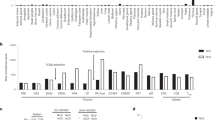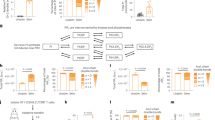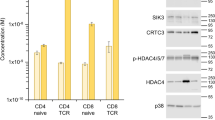Abstract
Inositol 1,4,5-trisphosphate (Ins(1,4,5)P3) is phosphorylated by Ins(1,4,5)P3 3-kinase, generating inositol 1,3,4,5-tetrakisphosphate (Ins(1,3,4,5)P4). The physiological function of Ins(1,3,4,5)P4 is still unclear, but it has been reported to be a potential modulator of calcium mobilization. Disruption of the gene encoding the ubiquitously expressed Ins(1,4,5)P3 3-kinase isoform B (Itpkb) in mice caused a severe T cell deficiency due to major alterations in thymocyte responsiveness and selection. However, we were unable to detect substantial defects in Ins(1,4,5)P3 amounts or calcium mobilization in Itpkb−/− thymocytes. These data indicate that Itpkb and Ins(1,3,4,5)P4 define an essential signaling pathway for T cell precursor responsiveness and development.
This is a preview of subscription content, access via your institution
Access options
Subscribe to this journal
Receive 12 print issues and online access
$209.00 per year
only $17.42 per issue
Buy this article
- Purchase on Springer Link
- Instant access to full article PDF
Prices may be subject to local taxes which are calculated during checkout








Similar content being viewed by others
References
Irvine, R.F. & Schell, M.J. Back in the water: the return of the inositol phosphates. Nat. Rev. Mol. Cell Biol. 2, 327–338 (2001).
Shears, S.B. The versatility of inositol phosphates as cellular signals. Biochim. Biophys. Acta 1436, 49–67 (1998).
Zilberman, Y., Howe, L.R., Moore, J.P., Hesketh, T.R. & Metcalfe, J.C. Calcium regulates inositol 1,3,4,5-tetrakisphosphate production in lysed thymocytes and in intact cells stimulated with concanavalin A. EMBO J. 6, 957–962 (1987).
Guse, A.H., Greiner, E., Emmrich, F. & Brand, K. Mass changes of inositol 1,3,4,5,6-pentakisphosphate and inositol hexakisphosphate during cell cycle progression in rat thymocytes. J. Biol. Chem. 268, 7129–7133 (1993).
Communi, D., Vanweyenberg, V. & Erneux, C. Molecular study and regulation of D-myo-inositol 1,4,5-trisphosphate 3-kinase. Cell Signal. 7, 643–650 (1995).
Dewaste, V. et al. Cloning and expression of a cDNA encoding human inositol 1,4,5-trisphosphate 3-kinase C. Biochem. J. 352, 343–351 (2000).
Dewaste, V., Roymans, D., Moreau, C. & Erneux, C. Cloning and expression of a full-length cDNA encoding human inositol 1,4,5-trisphosphate 3-kinase B. Biochem. Biophys. Res. Commun. 291, 400–405 (2002).
Takazawa, K., Perret, J., Dumont, J.E. & Erneux, C. Molecular cloning and expression of a human brain inositol 1,4,5-trisphosphate 3-kinase. Biochem. Biophys. Res. Commun. 174, 529–535 (1991).
Vanweyenberg, V., Communi, D., D'Santos, C.S. & Erneux, C. Tissue- and cell-specific expression of Ins(1,4,5)P3 3-kinase isoenzymes. Biochem. J. 306, 429–435 (1995).
Dewaste, V. et al. The three isoenzymes of human inositol 1,4,5-trisphosphate 3-kinase show specific intracellular localization but comparable Ca2+ responses upon transfection in COS-7 cells. Biochem. J. 374, 41–49 (2003).
Mailleux, P., Takazawa, K., Erneux, C. & Vanderhaeghen, J.J. Inositol 1,4,5-trisphosphate 3-kinase distribution in the rat brain. High levels in the hippocampal CA1 pyramidal and cerebellar Purkinje cells suggest its involvement in some memory processes. Brain Res. 539, 203–210 (1991).
Jun, K. et al. Enhanced hippocampal CA1 LTP but normal spatial learning in inositol 1,4,5-trisphosphate 3-kinase(A)-deficient mice. Learn. Mem. 5, 317–330 (1998).
Singer, S.M. & Nash, T.E. T-cell-dependent control of acute Giardia lamblia infections in mice. Infect. Immun. 68, 170–175 (2000).
Farr, A.G. & Anderson, S.K. Epithelial heterogeneity in the murine thymus: fucose-specific lectins bind medullary epithelial cells. J. Immunol. 134, 2971–2977 (1985).
Starr, T.K., Jameson, S.C. & Hogquist, K.A. Positive and negative selection of T cells. Annu. Rev. Immunol. 21, 139–176 (2003).
Kisielow, P., Bluthmann, H., Staerz, U.D., Steinmetz, M. & von Boehmer, H. Tolerance in T-cell-receptor transgenic mice involves deletion of nonmature CD4+8+ thymocytes. Nature 333, 742–746 (1988).
Hogquist, K.A. et al. T cell receptor antagonist peptides induce positive selection. Cell 76, 17–27 (1994).
Swat, W., Dessing, M., von Boehmer, H. & Kisielow, P. CD69 expression during selection and maturation of CD4+8+ thymocytes. Eur. J. Immunol. 23, 739–746 (1993).
Sentman, C.L., Shutter, J.R., Hockenbery, D., Kanagawa, O. & Korsmeyer, S.J. bcl-2 inhibits multiple forms of apoptosis but not negative selection in thymocytes. Cell 67, 879–888 (1991).
Zhu, D.M., Tekle, E., Chock, P.B. & Huang, C.Y. Reversible phosphorylation as a controlling factor for sustaining calcium oscillations in HeLa cells: Involvement of calmodulin-dependent kinase II and a calyculin A-inhibitable phosphatase. Biochemistry 35, 7214–7223 (1996).
Hermosura, M.C. et al. InsP4 facilitates store-operated calcium influx by inhibition of InsP3 5-phosphatase. Nature 408, 735–740 (2000).
Loomis-Husselbee, J.W. et al. Modulation of Ins(2,4,5)P3-stimulated Ca2+ mobilization by ins(1,3,4,5)P4: enhancement by activated G-proteins, and evidence for the involvement of a GAP1 protein, a putative Ins(1,3,4,5)P4 receptor. Biochem. J. 331, 947–952 (1998).
Coulie, P.G. et al. Identification of a murine monoclonal antibody specific for an allotypic determinant on mouse CD3. Eur. J. Immunol. 21, 1703–1709 (1991).
Serfling, E. et al. The role of NF-AT transcription factors in T cell activation and differentiation. Biochim. Biophys. Acta 1498, 1–18 (2000).
Oukka, M. et al. The transcription factor NFAT4 is involved in the generation and survival of T cells. Immunity. 9, 295–304 (1998).
van Ewijk, W., Shores, E.W. & Singer, A. Crosstalk in the mouse thymus. Immunol. Today 15, 214–217 (1994).
El Daher, S.S. et al. Distinct localization and function of (1,4,5)IP3 receptor subtypes and the (1,3,4,5)IP4 receptor GAP1(IP4BP) in highly purified human platelet membranes. Blood 95, 3412–3422 (2000).
Dolmetsch, R.E., Xu, K. & Lewis, R.S. Calcium oscillations increase the efficiency and specificity of gene expression. Nature 392, 933–936 (1998).
da Silva, C.P., Emmrich, F. & Guse, A.H. Adriamycin inhibits inositol 1,4,5-trisphosphate 3-kinase activity in vitro and blocks formation of inositol 1,3,4,5-tetrakisphosphate in stimulated Jurkat T-lymphocytes. Does inositol 1,3,4,5-tetrakisphosphate play a role in Ca2+-entry? J. Biol. Chem. 269, 12521–12526 (1994).
Cullen, P.J. et al. Identification of a specific Ins(1,3,4,5)P4-binding protein as a member of the GAP1 family. Nature 376, 527–530 (1995).
Cullen, P.J. Bridging the GAP in inositol 1,3,4,5-tetrakisphosphate signalling. Biochim. Biophys. Acta 1436, 35–47 (1998).
Amsen, D., Kruisbeek, A., Bos, J.L. & Reedquist, K. Activation of the Ras-related GTPase Rap1 by thymocyte TCR engagement and during selection. Eur. J. Immunol. 30, 2832–2841 (2000).
Dong, C., Davis, R.J. & Flavell, R.A. MAP kinases in the immune response. Annu. Rev. Immunol. 20, 55–72 (2002).
Werlen, G., Hausmann, B., Naeher, D. & Palmer, E. Signaling life and death in the thymus: timing is everything. Science 299, 1859–1863 (2003).
Walker, S.A. et al. Analyzing the role of the putative inositol 1,3,4,5-tetrakisphosphate receptor GAP1IP4BP in intracellular Ca2+ homeostasis. J. Biol. Chem. 277, 48779–48785 (2002).
Clement, S. et al. The lipid phosphatase SHIP2 controls insulin sensitivity. Nature 409, 92–97 (2001).
Takazawa, K. et al. Rat brain inositol 1,4,5-trisphosphate 3-kinase. Ca2+-sensitivity, purification and antibody production. Biochem. J. 268, 213–217 (1990).
Leo, O., Foo, M., Sachs, D.H., Samelson, L.E. & Bluestone, J.A. Identification of a monoclonal antibody specific for a murine T3 polypeptide. Proc. Natl. Acad. Sci. USA 84, 1374–1378 (1987).
Pajak, B. et al. Immunohistowax processing, a new fixation and embedding method for light microscopy, which preserves antigen immunoreactivity and morphological structures: visualisation of dendritic cells in peripheral organs. J. Clin. Pathol. 53, 518–524 (2000).
Baus, E., Urbain, J., Leo, O. & Andris, F. Flow cytometric measurement of calcium influx in murine T cell hybrids using Fluo-3 and an organic-anion transport inhibitor. J. Immunol. Methods 173, 41–47 (1994).
Acknowledgements
We thank E. Marion, O. Giot, C. Jacques and C. Moreau for technical assistance; the staff of the Laboratoire de Physiologie Animale for immunohistochemistry, technical discussions and help; A. Nagy for R1 embryonic stem cells; K. Rajewsky and R. Merino for anti–H-Y TCR and LckPr–Bcl2 transgenic mice, respectively; and J. Penninger for reviewing the manuscript. Supported by the Fondation David et Alice Van Buuren and the Fondation Hoguet (V.P.), and the Fonds de la Recherche Scientifique Médicale de Belgique, Interreg II (cofinanced by the Région Wallonne and the European Commission, FEDER), Action de Recherche Concertée of the Communauté Française de Belgique, and The Free University of Brussels.
Author information
Authors and Affiliations
Corresponding author
Ethics declarations
Competing interests
The authors declare no competing financial interests.
Supplementary information
Rights and permissions
About this article
Cite this article
Pouillon, V., Hascakova-Bartova, R., Pajak, B. et al. Inositol 1,3,4,5-tetrakisphosphate is essential for T lymphocyte development. Nat Immunol 4, 1136–1143 (2003). https://doi.org/10.1038/ni980
Received:
Accepted:
Published:
Issue Date:
DOI: https://doi.org/10.1038/ni980
This article is cited by
-
Substrate promiscuity of inositol 1,4,5-trisphosphate kinase driven by structurally-modified ligands and active site plasticity
Nature Communications (2024)
-
ROS-regulated phosphorylation of ITPKB by CAMK2G drives cisplatin resistance in ovarian cancer
Oncogene (2022)
-
Regulation of immune cell development through soluble inositol-1,3,4,5-tetrakisphosphate
Nature Reviews Immunology (2010)
-
Inositol trisphosphate 3-kinases: focus on immune and neuronal signaling
Cellular and Molecular Life Sciences (2010)
-
Differential Regulation of Immune Responses and Macrophage/Neuron Interactions in the Dorsal Root Ganglion in Young and Adult Rats following Nerve Injury
Molecular Pain (2009)



